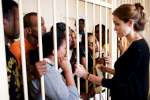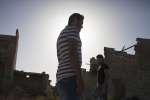- Text size
 |
|  |
|  |
| 
- Français
Mediterranean smugglers cram burn victims onto boat, one dead
Briefing Notes, 17 April 2015
This is a summary of what was said by UNHCR spokesperson Adrian Edwards – to whom quoted text may be attributed – at the press briefing, on 17 April 2015, at the Palais des Nations in Geneva.
Earlier this morning, at around 1am, an Italian naval vessel docked in Lampedusa carrying 70 people – mainly refugees – rescued from a deflated dinghy and in a state of severe shock. Among them was the body of a woman who had perished during the journey, apparently from burns.
The woman was not the only burn victim aboard. Twenty other people, including a six month old child were all suffering burn injuries, some of them grave. The survivors told UNHCR staff that they were victims of a cooking gas explosion at a holding centre run by smugglers in Libya, and that they had been left without treatment and eventually forced onto the dinghy with their wounds untreated. They had been drifting at sea for two days before their rescue.
The group, comprising 47 men, 21 women and two children, are mostly from Eritrea and Somalia – both significant refugee producing countries. They were disembarked, with five transferred by helicopter to hospitals in Sicily and 20 sent for medical treatment at the island health facility. The rest were transferred to a reception facility. A three-year-old boy, whose mother is in hospital in Sicily, has been placed in the custody of the director of the reception centre. Our partner, Save the Children, is following up with family tracing.
This latest horrific incident involving human smugglers shows the urgent need to create safe legal alternatives so that refugees don't need to put their lives at risk in this way.
So far in 2015, over 35,000 refugees and migrants have crossed the Mediterranean Sea (including 23,500 who landed in Italy and over 12,000 in Greece). At the same time, some 950 people have been reported dead or missing at sea. Last year some 219,000 refugees and migrants crossed the Mediterranean (Italy alone received over 170,000). Most of them were rescued by the Italian Navy, the Coast Guard or merchant vessels. It is estimated that some 3,500 people lost their lives at sea last year.
UNHCR has been advocating for a comprehensive and urgent response from the European Union and its member states to deal with the challenges posed by the thousands of refugees and migrants who risk their lives trying to reach Europe each year. UNHCR has shared specific proposals, including establishing a European robust search and rescue operation, a possible EU scheme to compensate shipping companies involved in rescuing people at sea, increasing credible legal alternatives to dangerous voyages – such as resettlement, humanitarian visas, and other innovative solutions – and a pilot relocation programme for Syrians refugees arriving to Italy and Greece.
NOTE: Video images and script are available here.
For more information on this topic, please contact:
- In Geneva, Adrian Edwards: +41 79 557 9120
- In Geneva, William Spindler: +41 79 217 3011
- In Rome, Federico Fossi: +39 349 0843461
- In Rome, Barbara Molinario: +39 06 802 123 33





















